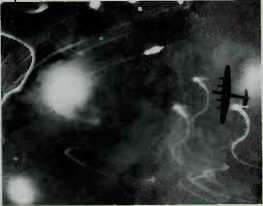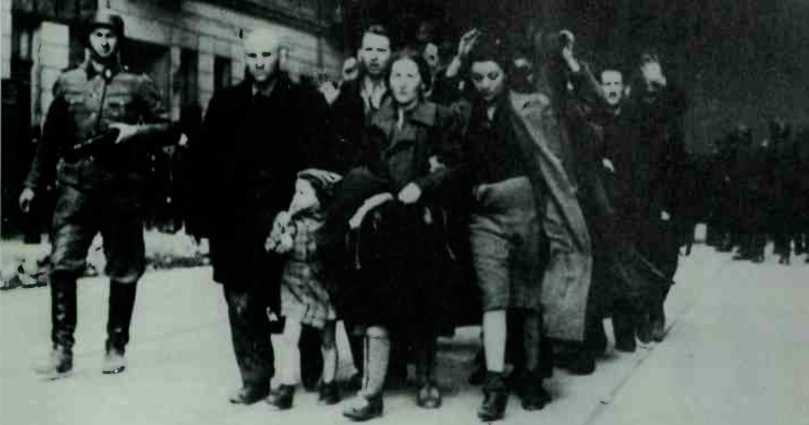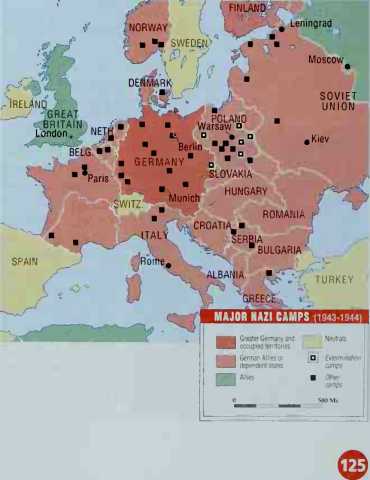In the spring of 1942, Allied forces began attacking the German population from the air. The Royal Air Force (RAF) had been running bombing raids on Germany since 1940. The raids, though, had been carried out by a few small bombers and had little success hitting their targets, usually factories.
Bombing of Civilians, now the battle plan changed.
Instead of aiming for specific factories, RAF bombers would go after built-up areas, especially workers’ neighborhoods (see sidebar). At the end of May, in a spectacular and punishing attack, 1,000 RAF planes raided the city of Cologne.
Other cities would follow. In July 1942, the United States also flew its first daylight raids against ‘‘Fortress Europe.”
Jews TaRGETEO. within Europe’s fortress, Hitler continued his outrageous treatment of the Jewish people. After the invasion of Poland, Jews who were not immediately killed were herded into ghettos in the larger cities. The Germans used the ghetto residents as slave laborers. They were given little food or medicine. Where one family had lived, several were crowded together.
People, especially the old or weak, became sick. Without medicine or proper care, they usually died.
The immediate fate of Russian Jews was even worse. When Hitler invaded the Soviet Union, death squads forced Jewish villagers to dig large trenches. When they were finished, German soldiers machine-gunned them into the opened graves. These executions were so grisly that the Nazis had difficulty finding soldiers to carry out the killings.
Extermination Camps, still, Europe’s Jews were not
Dying fast enough for Hitler. He and his staff members worked out plans for a “Final Solution.” At the Wannsee Conference on January 20, 1942, senior Nazi officials laid out plans to sweep all Jews from Europe. Those who were able to do hard manual labor would build roads and do other work until they were dead or no longer needed. The rest would be exterminated.
Mass executions began at Auschwitz concentration camp in Poland. Soon work began on other camps: Sobibor, Treblinka, Chelmno, Belzec, and others (see map). These camps were equipped with gas chambers that could kill thousands of Jews every day.
Non-Jewish Germans were warned against feeling Sony for the Jews. Hitler’s propaganda minister, Joseph Goebbels, wrote: “Feelings of sympathy or pity are entirely inappropriate.” The Jews, he insisted, were only getting what they deserved.
Hitler’s program for extermination was carefully controlled; there was little opportunity for anyone to protest. To make matters worse, anti-Semitic feelings in many countries in Europe caused some people to aid the Nazis in their brutal treatment of the Jews.

In the spring of 1942, British Air Marshai Arthur Harris took over the Ailied Bomber Command. Instead of aiming for specified miiifary or industriai fargets in Germany, the
Aiiies began mass bombing raids. These raids used hundreds of bombers to smash Germany’s most popuiated cities. Neariy
600,000 German civiiians died in these attacks. More than 3 miiiion homes were destroyed. Neariy every major city in Germany was heaviiy damaged.
The rain of incendiary bombs and explosives was so fierce that, in a few cases, firestorms occurred. In closely built-up areas, multiple fires creafed a storm with superheated hurricane winds. Temperatures at the center of fhe storm reached 800 degrees centigrade. Even people in bomb shelters were poisoned by smoke, suffocated, or burned to death.
The first firestorm occurred in Hamburg in late
July 1943. About 40,000 people died. One bomber pilot described the scene as “an active volcano... Our actual bombing was like putting another shovelful of coal into the furnace.”
A German teenage girl, running from the flames in Hamburg, described her neighborhood as fhe firestorm struck:
“14/e... couldn’t go across the street because the asphalt had melted. There were people on the roadway, some already dead, some still lying alive but stuck in the asphalt They must have rushed onto the roadway without thinking. Their feet had got stuck and then they had put out their hands to try to get out again. They were on their hands and knees screaming. ”

German soldiers liquidate the Warsaw ghetto in Poland. The Nazis were systematically murdering European Jews.
Some Jews were able to resist the Nazis, though their fight was usually short-lived. Before they could be rounded up, a few escaped into the forests of Poland and the Soviet Union. From there, some formed partisan groups that worked against the Germans during the war.
“One of our greatest mistakes in the First World War was to spare the lives of enemy civilians. We shall... destroy at least one third of the population of all adjacent territories. ”
— German Field Marshall Gerd von Rnndstedt
Large-scale attempts to resist always failed. In April and May 1943, the residents of the large Jewish ghetto in Warsaw, Poland, rose up against their Nazi oppressors. The revolt was brutally crushed.
Lidice Massacre. The Jews were Hillers principal civilian target, but the Nazis took brutal revenge on many others who tried to stand in their way. In 1942, a Nazi Gestapo leader was assassinated by the Czechoslovakians. In retaliation, the Germans destroyed the Czech village of Lidice. All the men over si. xteen years of age were murdered. The rest of the 1,200 people were sent to concentration camps.





 World History
World History









